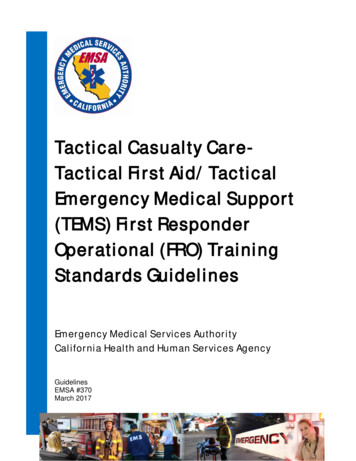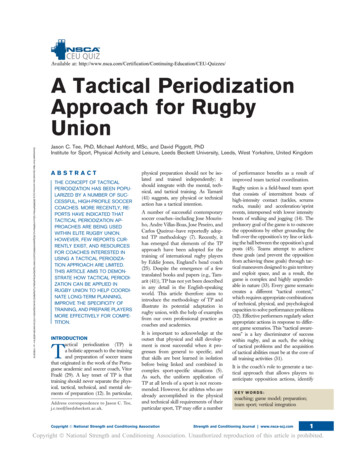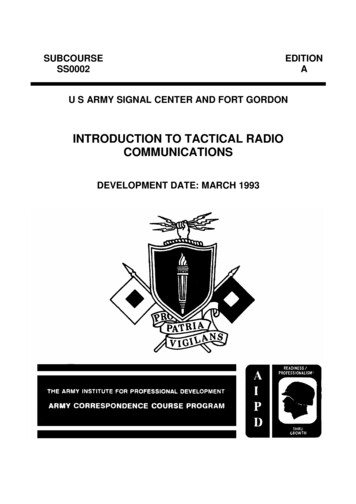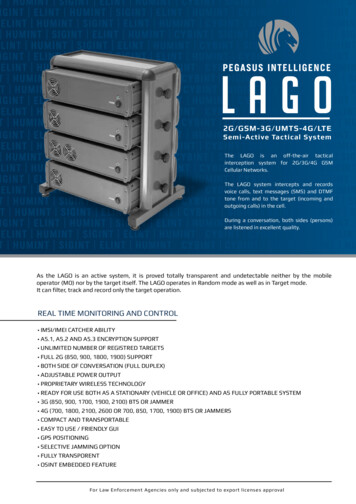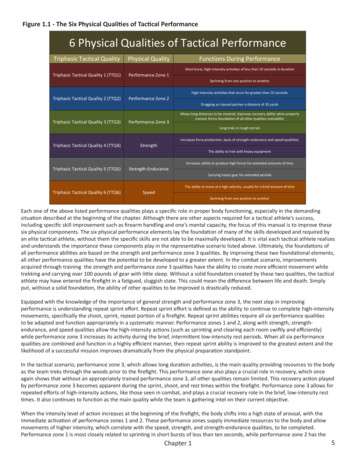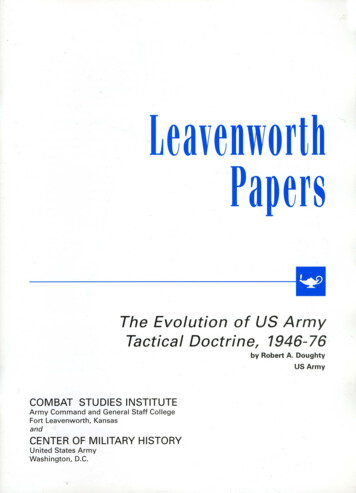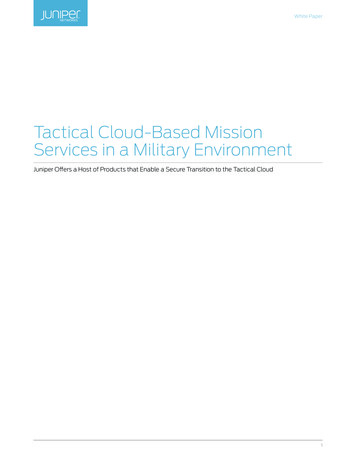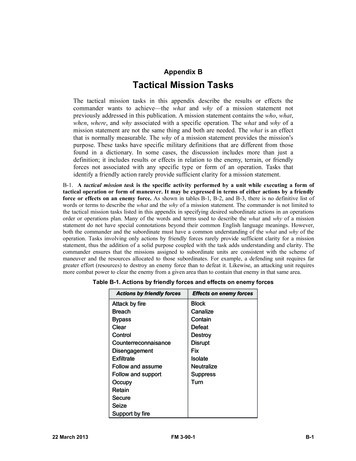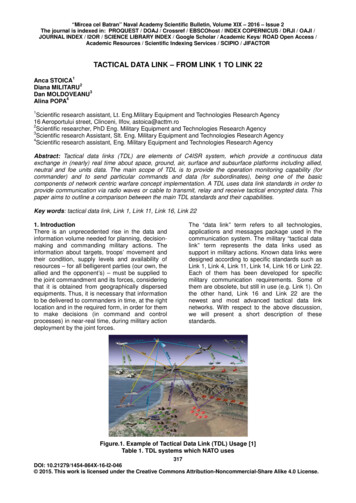
Transcription
“Mircea cel Batran” Naval Academy Scientific Bulletin, Volume XIX – 2016 – Issue 2The journal is indexed in: PROQUEST / DOAJ / Crossref / EBSCOhost / INDEX COPERNICUS / DRJI / OAJI /JOURNAL INDEX / I2OR / SCIENCE LIBRARY INDEX / Google Scholar / Academic Keys/ ROAD Open Access /Academic Resources / Scientific Indexing Services / SCIPIO / JIFACTORTACTICAL DATA LINK – FROM LINK 1 TO LINK 221Anca STOICA2Diana MILITARU3Dan MOLDOVEANU4Alina POPA1Scientific research assistant, Lt. Eng.Military Equipment and Technologies Research Agency16 Aeroportului street, Clinceni, Ilfov, astoica@acttm.ro2Scientific researcher, PhD Eng. Military Equipment and Technologies Research Agency3Scientific research Assistant, Slt. Eng. Military Equipment and Technologies Research Agency4Scientific research assistant, Eng. Military Equipment and Technologies Research AgencyAbstract: Tactical data links (TDL) are elements of C4ISR system, which provide a continuous dataexchange in (nearly) real time about space, ground, air, surface and subsurface platforms including allied,neutral and foe units data. The main scope of TDL is to provide the operation monitoring capability (forcommander) and to send particular commands and data (for subordinates), being one of the basiccomponents of network centric warfare concept implementation. A TDL uses data link standards in order toprovide communication via radio waves or cable to transmit, relay and receive tactical encrypted data. Thispaper aims to outline a comparison between the main TDL standards and their capabilities.Key words: tactical data link, Link 1, Link 11, Link 16, Link 221. IntroductionThere is an unprecedented rise in the data andinformation volume needed for planning, decisionmaking and commanding military actions. Theinformation about targets, troops’ movement andtheir condition, supply levels and availability ofresources – for all belligerent parties (our own, theallied and the opponent’s) – must be supplied tothe joint commandment and its forces, consideringthat it is obtained from geographically dispersedequipments. Thus, it is necessary that informationto be delivered to commanders in time, at the rightlocation and in the required form, in order for themto make decisions (in command and controlprocesses) in near-real time, during military actiondeployment by the joint forces.The “data link” term refers to all technologies,applications and messages package used in thecommunication system. The military “tactical datalink” term represents the data links used assupport in military actions. Known data links weredesigned according to specific standards such asLink 1, Link 4, Link 11, Link 14, Link 16 or Link 22.Each of them has been developed for specificmilitary communication requirements. Some ofthem are obsolete, but still in use (e.g. Link 1). Onthe other hand, Link 16 and Link 22 are thenewest and most advanced tactical data linknetworks. With respect to the above discussion,we will present a short description of thesestandards.Figure.1. Example of Tactical Data Link (TDL) Usage [1]Table 1. TDL systems which NATO uses317DOI: 10.21279/1454-864X-16-I2-046 2015. This work is licensed under the Creative Commons Attribution-Noncommercial-Share Alike 4.0 License.
“Mircea cel Batran” Naval Academy Scientific Bulletin, Volume XIX – 2016 – Issue 2The journal is indexed in: PROQUEST / DOAJ / Crossref / EBSCOhost / INDEX COPERNICUS / DRJI / OAJI /JOURNAL INDEX / I2OR / SCIENCE LIBRARY INDEX / Google Scholar / Academic Keys/ ROAD Open Access /Academic Resources / Scientific Indexing Services / SCIPIO / JIFACTORLink typeUser communityLink 1Aerial situationLink 11Marine controlAerial controlLink 11BAerial defenseLink 16JointLink 22JointApplicationInterfaces with other networks (aerial control/ aerial defense), withmobile systems and with the primary users group.Provides tracking data exchange for image compilation andtransmission of orders in the C2 domain.Tactical information exchange between soil-based weapon systems, C2and surveillance systems and Link 11 network participating units.High-throughput digital data link, without a nodal point (hub), whichincludes EPM for engaging a multiple combat environment (terrestrial,naval and aerial combat)Designed for ensuring connectivity outside the direct line-of-sight(BLOS), using DTDMA architecture.2. Tactical Data Link (TDL)The joint operations command must have TDLequipments in order to benefit from MIDS(Multifunctional Information Distribution Systems)networks input data, introduced by terrestrialforces, aerial forces, marine forces and militaryinformation organizations, according to thecommandment’s needs (as per its tasks andabilities), as well as to introduce specific data intothese networks (figure 1). Table 1 presentsgeneral characteristics of TDLs.TDL systems are potential solutions forimplementing the concept of Joint Intelligence,Surveillance and Reconnaisance (JISR). Themain JISR missions are: early warning,information support for operations planning,information about the enemy and the environmentfor situational assessment , data and informationabout targets, informational operations support,information for risk assessment and troopsprotection, The accomplishment of these missionsdepends on the TDLs specifications which willcomply the following requirements: regularity,clarity, conciseness, standardization, verification,selective distribution and classification ofinformation.Depending on what messages are used to conveytactical data, the main TDL functions are:a. TDL parameters information exchange;b. Network management;c. PreciseParticipantLocationandIdentification (PPLI)d. Air surveillance;e. Land surveillance;f. Terrestrial surveillance;g. Space surveillance;h. Electronic surveillance;i. Electronic warfare (EW);j. Intelligence;k. Mission management;l. Weapons coordination and management;m. Air control;n. Managementul informatic;o. Free text exchange;p. Voice communication exchange.TDL usage depends on the military area ofoperation or drill area, as seen in Table 2.Table 2. TDL functional areasLinkLinkFunctional areas1116StatusmonitoringplatformAir surveillanceLand surveillanceSurface surveillanceSubsurfacesurveillanceSpace surveillanceElectronic warfareWeaponscoordinationCommandAircraft xxxxxxxxxxxxx-xxxx-xx-x-Data exchange capability imposes that thetransmission medium is available prior to initiatingand starting any TDL system for landlinecommunications and radio frequenciesallocation.The main characteristics of theequipments connection scheme in tactical datalinks are presented in Table 3.318DOI: 10.21279/1454-864X-16-I2-046 2015. This work is licensed under the Creative Commons Attribution-Noncommercial-Share Alike 4.0 License.
“Mircea cel Batran” Naval Academy Scientific Bulletin, Volume XIX – 2016 – Issue 2The journal is indexed in: PROQUEST / DOAJ / Crossref / EBSCOhost / INDEX COPERNICUS / DRJI / OAJI /JOURNAL INDEX / I2OR / SCIENCE LIBRARY INDEX / Google Scholar / Academic Keys/ ROAD Open Access /Academic Resources / Scientific Indexing Services / SCIPIO / JIFACTORTable 3. Characteristics of TDL networking schemeCharacteristicsLink 1Link 11Link 16Link 22FrequencySpeed (bit/sec)ECM resistanceCrypto-secureNodelessExtended LOSAntijamData rate (kbps)Standard messageParticipantsVoice circuitsArchitecturePoint-to-point land line1,2001.2S-seriesHF/ UHF1,800x1.3 2.25M series4 8Radio BroadcastUHF/ Spread 57,600xxxxx2.8 115.2J series 1282TDMAHF/UHF Spreadxxxx2.4J series40DTDMADuplex digital3. From Link 1 to Link 22In the Data Links evolution, there are two maingenerations. The first generation Data Links(Link1, Link4, Link11, Link11B, Link14) wasdeveloped on 8-bit computers, in 1950’s and1960’s, with limited functionality and slow datarates (600 - 2400 bps). The second generationData Links (Link16, Link22) was developed on 16bit computers, in the 1970’s and 1980’s, ismultifunctional and works at faster data rates(2400bps-1Mbps).3.1 Link 1Link 1 is a point-to-point tactical link based on afixed digital message set, which interconnectsEuropean NATO terrestrial counterair fixedlocations in order to exchange data andinformation regardingthe air situationalawareness in the main network group.3.2 Link 11Link 11 is a secure half-duplex tactical data radiolink used by NATO for digital informationtransmission among airborne, land-based, andship-board tactical data systems. Link 11 works inHF or UHF band. Currently Link 11 is intended tobe replaced by Link 22. The standard that definesits specification is MIL-STD-6011.3.3 Link 16Link 16 is a high-capacity datalink, with frequencyhopping features and jam resistance capabilities.Links 16 uses Joint Tactical InformationDistribution System (JTIDS) terminals andMultifunctional Information Distribution System(MIDS). Link 16 has implemented the TimeDivision Multiple Access (TDMA) technique, thatprovides 128 time slots/second for the JU (JTIDSUnits) participants. The time slots are organized inseveral functional groups of network users.Unlike Link1 and Link 11, Link 16 uses encryptiedhigh-capacity datalink, with no single point offailure (NCS), and provides electronic protectionmeasures for fully-operational communications incombat situations (air, terestrial, sea). In table no.2 there are ilustrated main characteristics of theTDL developed by NATO over the past decades,including the oldest and the newest technologiesavailable.The main purpose of Link 16 is to provide thesupport for real-time tactical information exchangebetween joint units. Link 16 is allowing the tacticalusage of the involved platforms (equiped with Link16) and provides enhanced communicationcapabilities , which include:: Nodelessness Jam resistance Increased data rate Increasedvolumeofinformationexchange Reduced data terminal size, allowinginstallation in fighter and attack aircraft Digitized, jam-resistant, secure voicecapability PreciseParticipantLocationandIdentification (PPLI)Main applications where Link16 Tactical Data Linkis used are: Surveillance Electronic War (EW) Mission Management (MM) / WeaponsCoordination (WC) Air control Fighter-to-fighter net Secure voice channels Navigation319DOI: 10.21279/1454-864X-16-I2-046 2015. This work is licensed under the Creative Commons Attribution-Noncommercial-Share Alike 4.0 License.
“Mircea cel Batran” Naval Academy Scientific Bulletin, Volume XIX – 2016 – Issue 2The journal is indexed in: PROQUEST / DOAJ / Crossref / EBSCOhost / INDEX COPERNICUS / DRJI / OAJI /JOURNAL INDEX / I2OR / SCIENCE LIBRARY INDEX / Google Scholar / Academic Keys/ ROAD Open Access /Academic Resources / Scientific Indexing Services / SCIPIO / JIFACTOR Network management.Link 16 is represented by several tactical datalinks which provide the information exchangeusing the Line of Sight radio medium. Theavailable Link 16 terminals are: JTIDS – first generation terminals,including Class1 and Class2 terminals(software, hardware, RF equipment, andhigh-capacity,secure,anti-jamwaveforms) MIDS-LVT - LVT1-LVT11 is the secondgeneration class of Link 16 equipments JTRS şi MIDS JTRS – the futuregeneration of Link 16 terminals.3.4 Link 22Same as Link 11, Link 22 is a secure digital radiolink that works in the HF and UHF bands thatprovide the support for data exchange betweenair, ground, and navy of all the allied forces.The one important thing about Link 22 is the factthat enables BLOS (Beyond Line of Sight)communication capabilities, so in the HF bandLink 22 is able to provide communications up to300 nautical miles distance. Unlike the HFcommunications which can provide both LOS andBLOS communications, the UHF band isdesignated only for LOS transmissions.Figure 2. Link 22 Network Overview [1]As we mentioned before, the Link 11 capabilitieswere limited, so the Link 22 initial program (NILE– NATO Improvement Link Eleven) objectives are: Link 11 upgrading and improvement; Allied Forces interoperability increasing; Link 16 complementary; C4ISR capabilities enhancement.A visible improvement of Link 11 is the fact thatLink 22 is able to be operational even in badtransmissionconditions;itprovidescommunication although at a lower data rate. Incase of a specific unit failure, the whole networkwill not be affected because of the distributedprotocols usage.The design of Link 22 was similar to the standardISO communications stack concept, whichconsists of several layers with individual andspecific functions (Figure 3).Figure 3. The equivalent ISO OSI reference model [1]320DOI: 10.21279/1454-864X-16-I2-046 2015. This work is licensed under the Creative Commons Attribution-Noncommercial-Share Alike 4.0 License.
“Mircea cel Batran” Naval Academy Scientific Bulletin, Volume XIX – 2016 – Issue 2The journal is indexed in: PROQUEST / DOAJ / Crossref / EBSCOhost / INDEX COPERNICUS / DRJI / OAJI /JOURNAL INDEX / I2OR / SCIENCE LIBRARY INDEX / Google Scholar / Academic Keys/ ROAD Open Access /Academic Resources / Scientific Indexing Services / SCIPIO / JIFACTORA synthetic comparison between Link11 and Link 22 is presented in Table 4Function/SpecificationNetwork AccessTable 4. A synthetic comparison between Link11 and Link 22Parameters/Advantages/LimitationsLink 11-TDMA accessPrioritization of messagesfeatureNo options-Priority Injection feature-Limited number ofparticipants (62)-More units (125)-Limited areaDependence of the platformsand their positionsUnits must be all connectedwith the NCS-No limitation (it uses the WGS84 System);Increased area of operation;Flexibile network;LOS and BLOS capabilities;Routing&relay protocols.-Strong encryption system.Strong security.--Increased net cycle timesLarge access delayEmergency calls-CapacityArea Low encryption levelWeak security.TransmissionSecurity-Fixed HF or UHFfrequencies;Jam vulnerabilities.-Frequency hoping solutionsprovide reliablecommunications;Fixed frequencycommunications are not soaffected as Link 11 because ofthe multiple networks-No NCS requiredNo single point of failure-Special mechanism for badtransmission conditionsMore robust waveformsNCS failure-If NCS is down the entirenetwork will be affectedReliability-Bad conditions could affectthe transmissionLimited waveformsavailabilityBandwidthLink 22-Limited BandwidthTransmission rates from1,090 bit/s to 1,800 bit/s-Wider BandwidthTransmission rates from 1,493bit/s to 12,666 bit/sCONCLUSIONSTactical Data Links provide near-real time combat information to U.S. and NATO allies about the integratedair picture with both friendly and hostile aircraft locations, and general situational awareness data, includingdefence threats. This contributes to an integrated control of fighters by either ground-based or airbornecontrollers, which will increase the fighters’ situational awareness and the ability to engage targets or to avoidthreats, thereby increasing mission effectiveness.TDL capabilities offer a near-term solution for exchanging information over a common network that iscontinuously and automatically updated.TDL ensure the hardware and software support for communication capabilities in C4ISR applications duringpeacetime, as well as fight exercises and war. They are meant to serve NATO as well as the allied forces,which contribute to its continuous improvement according to threats and vulnerabilities dynamic. Currently,even Link16 and Link22 undergo a continuous adaptation process to new IT&C technologies developed andimplemented in NATO deployable networks.321DOI: 10.21279/1454-864X-16-I2-046 2015. This work is licensed under the Creative Commons Attribution-Noncommercial-Share Alike 4.0 License.
“Mircea cel Batran” Naval Academy Scientific Bulletin, Volume XIX – 2016 – Issue 2The journal is indexed in: PROQUEST / DOAJ / Crossref / EBSCOhost / INDEX COPERNICUS / DRJI / OAJI /JOURNAL INDEX / I2OR / SCIENCE LIBRARY INDEX / Google Scholar / Academic Keys/ ROAD Open Access /Academic Resources / Scientific Indexing Services / SCIPIO / JIFACTORBIBILOGRAPHY[1] Understanding Voice and Data Link Networking, Northrop Grumman, December 2014[2] Link 22 Guidebook Overview, Northrop Grumman, July 2013[3] Introduction to tactical digital information Link J and quick reference guide, Air Land Sea ApplicationCenter, June 2000[4] https://en.wikipedia.org/wiki/Link 22[5] https://en.wikipedia.org/wiki/MIL-STD-6011[6] https://en.wikipedia.org/wiki/Link 16322DOI: 10.21279/1454-864X-16-I2-046 2015. This work is licensed under the Creative Commons Attribution-Noncommercial-Share Alike 4.0 License.
paper aims to outline a comparison between the main TDL standards and their capabilities. Key words: tactical data link, Link 1, Link 11, Link 16, Link 22 . 1. Introduction . There is an unprecedented rise in the data and information volume needed for planning, decision-making and commanding military actions. The
